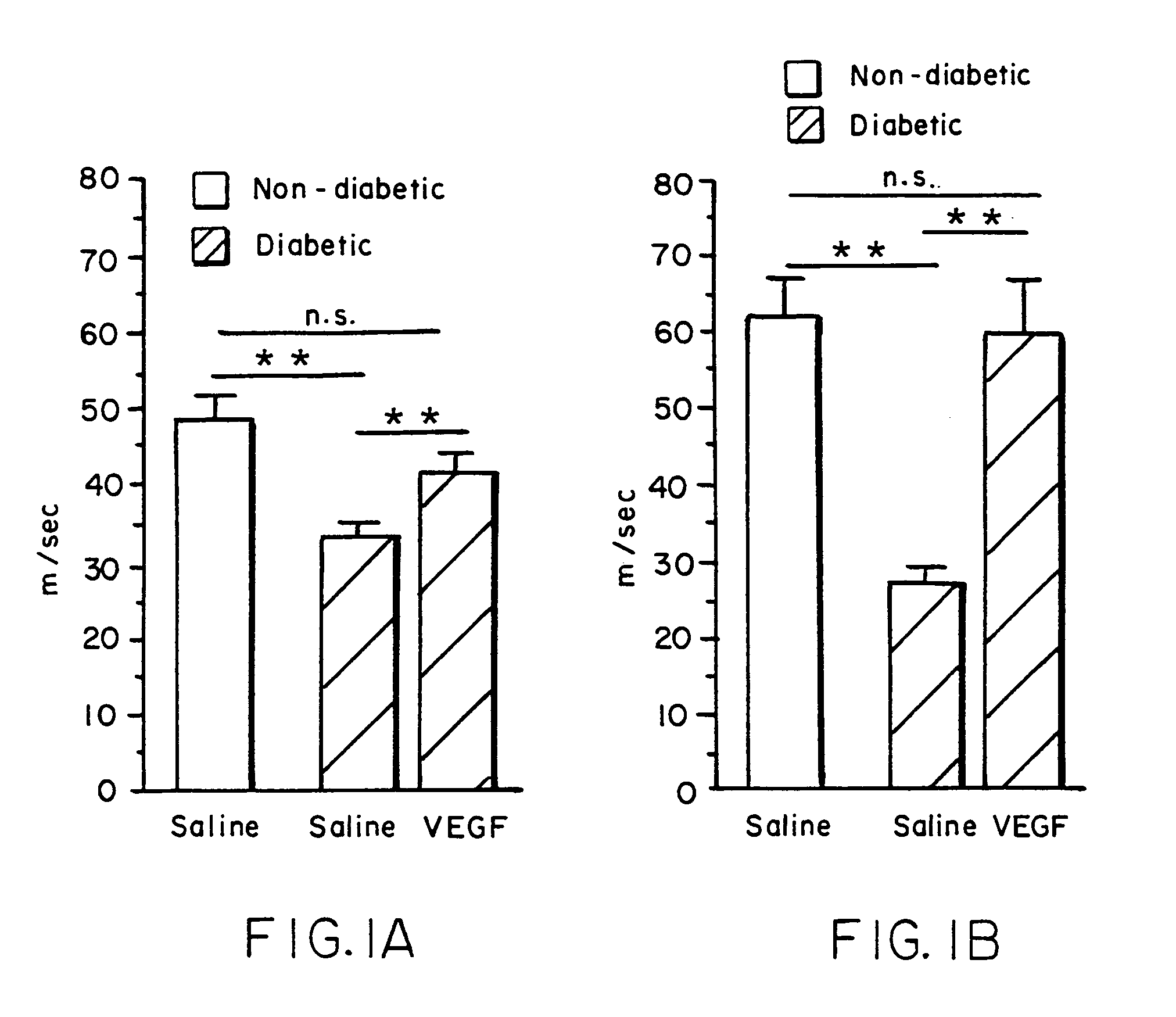Angiogenic growth factors for treatment of peripheral neuropathy
a growth factor and peripheral neuropathy technology, applied in the field of peripheral neuropathy treatment, can solve the problems of ischemic peripheral neuropathy, limited study, and exacerbated threat of limb loss, so as to improve peripheral neuropathy, prevent or reduce ischemia-induced nerve damage, and improve sensory neuropathy
- Summary
- Abstract
- Description
- Claims
- Application Information
AI Technical Summary
Benefits of technology
Problems solved by technology
Method used
Image
Examples
example 1
Define Certain Morphologic, Temporal, and Functional Aspects of Therapeutic Angiogenesis
[0093]A. Cellular proliferation contributing to the development of the nascent collateral circulation is augmented in ischemic limbs in response to therapeutic angiogenesis.
[0094]We determined the extent to which proliferative activity of vascular cells is augmented during therapeutic angiogenesis with VEGF (Takeshita S, et al., Am J Pathol 1995;147:1649–1660). Ten days following induction of limb ischemia by surgically excising femoral artery of rabbits, either VEGF (500–1,000 mg) or saline was administered as a bolus into the iliac artery of the ischemic limb. Cellular proliferation was evaluated by bromodeoxyuridine (BrDU) labeling for 24 hrs at day 0 (immediately prior to VEGF administration) and at days 3, 5, and 7 post-VEGF. EC proliferation in the midzone collaterals of VEGF-treated animals increased 2.8-fold at day 5 (p<0.05, vs. control), and returned to baseline levels by day 7. Smooth ...
example 2
Investigation of Certain Conditional Factors which May Modulate the Outcome of Therapeutic Angiogenesis
[0103]A. Hypoxia modulates the response to angiogenesis induced by VEGF and bFGF.
[0104]To evaluate this hypothesis, we investigated whether low oxygen tension or cytokines known to promote neovascularization in vivo could modulate the expression of VEGF or bFGF in human vascular smooth muscle cells (SMCs) (Brogi E, et al., Circulation 1994;90:649–652). SMCs were treated with platelet derived growth factor BB (PDGF BB) or transforming growth factor β1 (TGF-β1) or exposed to low oxygen tension in serum-free medium. Northern analysis detected low basal levels of VEGF and bFGF mRNA in extracts of unstimulated SMCs. However, both VEGF and bFGF transcripts increased following administration of PDGF BB (10 or 20 ng / ml) or TGF-β1 (0.1 or 1 ng / ml). Hypoxia was a potent stimulus for VEGF gene expression, but had no apparent effect on bFGF steady state mRNA levels. These results documented th...
example 3
The Impact of Growth Factor Selection, Mode of Delivery, and Use of Adjunctive Therapies in Optimizing the Anatomic and Physiologic Outcomes of Therapeutic Angiogenesis
[0113]A. The character and magnitude of cellular proliferation observed in response to VEGF may be modified by co-administration of a second angiogenic growth factor.
[0114]To test this hypothesis, we evaluated the extent of neovascularization which was achieved in vivo following intra-arterial administration of VEGF (500 μg) alone, bFGF (10 μg) alone, and VEGF(500 μg)+bFGF(10 μg) all as recombinant protein, to the internal iliac artery of the rabbit ischemic hindlimb (Asahara T, et al., Circulation 1995;92:II-365-II-371). Augmentation of calf blood pressure ratio as well as papaverine-induced maximum flow reserve was significantly (p<0.05) greater in the VEGF+bFGF group than the VEGF, bFGF, or saline control groups. The extent of neointimal thickening in the internal iliac artery at day 30 was not significantly differ...
PUM
| Property | Measurement | Unit |
|---|---|---|
| volume | aaaaa | aaaaa |
| temperature | aaaaa | aaaaa |
| pH | aaaaa | aaaaa |
Abstract
Description
Claims
Application Information
 Login to View More
Login to View More - R&D
- Intellectual Property
- Life Sciences
- Materials
- Tech Scout
- Unparalleled Data Quality
- Higher Quality Content
- 60% Fewer Hallucinations
Browse by: Latest US Patents, China's latest patents, Technical Efficacy Thesaurus, Application Domain, Technology Topic, Popular Technical Reports.
© 2025 PatSnap. All rights reserved.Legal|Privacy policy|Modern Slavery Act Transparency Statement|Sitemap|About US| Contact US: help@patsnap.com

